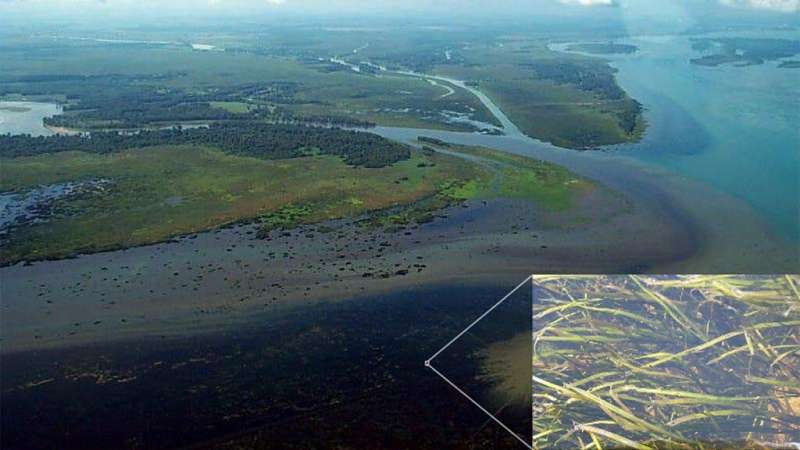High-frequency monitoring reveals riverine nitrogen removal

Humans tend to make messes, and when it comes to the excess nitrogen we contribute to waterways, aquatic plants get stuck cleaning up. Nutrients such as nitrogen in wastewater and agricultural runoff often escape into rivers, where they can overstimulate the growth of plankton, resulting in excessive algal blooms and oxygen-depleted conditions as they decompose. Submerged riverine plants can partially mitigate this effect by taking up nitrogen-containing compounds from the water.
In a study now published in Water Resources Research, researchers bring a new level of temporal resolution to this long-observed phenomenon, reporting on observations of nitrogen retention at a site where two agricultural tributaries join Lake Saint-Pierre on the St. Lawrence River in Québec, Canada. At the junction, a submerged plant meadow absorbs nitrogen and prevents much of it from reaching the St. Lawrence Estuary.
From June to November between 2012 and 2017, the researchers estimated the daily biomass of plants in the meadow by calculating changes in the slope of the water level caused by the vegetation using measurements from upstream and downstream of the study site. This approach was done using a model they developed through detailed plant biomass collection in the meadow across very different climatic years. Then they estimated the amount of nitrate entering the site from the tributaries and calculated the amount the plants processed by placing a high-resolution nitrate sensor at the edge of the meadow to measure the amount exiting.
By analyzing biomass levels, the authors related plant abundance to nitrogen retention, calculating the amount assimilated by plants and lost to the atmosphere through denitrification. On average, each square meter of the aquatic meadow removed about half a gram of nitrogen per day, the researchers estimated, resulting in up to 0.8 kiloton per year of nitrogen retained, or the amount generated by a city of a half million people—among the highest values reported so far in rivers. In years when biomass was low, only 47%–62% of the nitrogen put into the system was removed, whereas 63%–87% was removed in years when biomass was high.
Although the meadow is always performing this important ecosystem service, the researchers found that moderate rainfall and temperatures were optimal for denitrification because of high plant biomass, whereas extreme conditions reduced the fraction of nitrogen retained by the plant meadow. With climate change likely to increase the frequency of extreme weather, the future could see more nitrogen getting to the St. Lawrence Estuary, which could cause a higher incidence of blooms and oxygen depletion. Management actions should thus aim to preserve or restore this meadow and similar sites, the researchers wrote.
More information: M. Botrel et al, Climate‐Driven Variations in Nitrogen Retention From a Riverine Submerged Aquatic Vegetation Meadow, Water Resources Research (2022). DOI: 10.1029/2022WR032678
Journal information: Water Resources Research
Provided by Eos
This story is republished courtesy of Eos, hosted by the American Geophysical Union. Read the original story here.



















